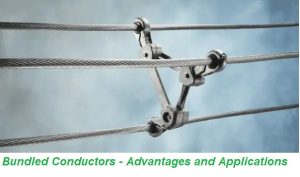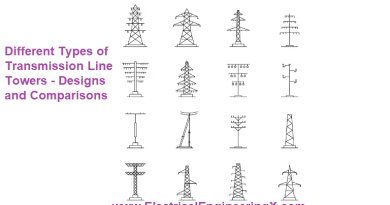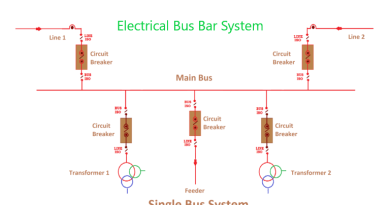What are Bundled Conductors? Their Advantages and Applications
What are Bundled Conductors? Their Advantages and Applications
Introduction
Bundled conductors refer to arrangements where multiple sub-conductors are run in parallel and spaced out while electrically and mechanically interconnected at regular intervals. Bundled conductors offer higher transmission capacity and improved line performance characteristics. Let’s explore bundled conductors, their advantages over single conductors, applications, design considerations, and emerging technologies.
In electrical engineering, a critical innovation has been steadily shaping the landscape of power transmission—bundled conductors. These ingenious configurations of conductive materials have revolutionized how we transmit electricity over vast distances, offering many advantages that boost efficiency, reliability, and sustainability. In this article, we will unravel the world of bundled conductors, exploring their definition, historical evolution, advantages, types, design intricacies, applications, challenges, and the exciting prospects they hold for the future.
What are Bundled Conductors?
Bundled conductors consist of two or more electrical sub-conductors bundled together and run in parallel but spaced apart through spacer dampers or spacers. The effective current carrying area is increased compared to a single conductor of the same material, enhancing the capacity.
In electrical transmission, bundle conductors are precisely what their name suggests: multiple individual conductors bundled together within a single transmission line. These conductors, typically composed of materials like aluminum or aluminum alloy, are strategically arranged and spaced, creating a compact and robust configuration. The concept of bundling conductors emerged as an ingenious solution to address the limitations of single conductors in high-voltage transmission lines.

Need for Bundled Conductors
- Carry higher currents and power loads than feasible with single conductors
- Reduce line impedance and associated voltage drop over long distances
- Control electric field at conductor surface to improve corona performance
- Limit audible noise and radio interferences from transmission lines
Bundled Conductor Configurations
Common configurations have vertical, horizontal, or triangular sub-conductor spacing. Optimal spacing depends on voltage, current, clearances, and performance objectives.
There are different types of bundled conductors:
Types of Bundled Conductors
Standard Bundles
Use the same material for all sub-conductors, like quadruple AAAC bundles.
Hybrid Bundles
Combine materials like ACSR and AAAC to optimize cost, strength, and conductivity.
High-Temperature Bundles
Use advanced sub-conductors like ACCC, ACCR, or GAP to increase thermal capacity.
Fault Current Limiting Bundles
Incorporate high-impedance wires to limit fault levels by increasing surge impedance.
Relative to single conductors, key advantages arise:
Comparison to Single Conductors
Current Carrying Capacity
Bundled conductors can have multiple times the ampacity of an equivalent single conductor.
Line Impedance
More sub-conductors in parallel reduce overall bundle impedance, achieving the Ferranti effect.
Corona Performance
Spacing maintains higher surface voltage gradients before corona onset.
Mechanical Strength
Individual slim sub-conductors are lighter than single heavy conductors, aiding handling.
Significant benefits are obtained by using bundled conductors:
Advantages of Bundled Conductors
Higher Ampacity
The current carrying capacity is increased proportionally to several sub-conductors.
Lower Line Impedance
Adding more parallel paths with an equal total cross-section reduces impedance.
Better Voltage Regulation
Lower impedance minimizes reactive voltage drops, improving regulation over long lines.
Enhanced Corona Performance
Wider spacing lowers electric field strength at the conductor surface, postponing the corona.
Increased Power Handling Capability
Bundled conductors can transmit over 50% more power than single conductors of the same conductor metal volume.
Improved Efficiency
Lower resistance loss per unit load enables more efficient bulk power delivery over hundreds of kilometers.
Key applications where bundled conductors provide advantages:
Applications of Bundled Conductors
Long Distance Transmission
Optimized bundled conductors enable increased capacity transmission links interconnecting grids across regions.
Interconnecting Grids
Enable bulk power transfer between utility areas with lower losses by reducing reactance.
Compact Urban Lines
Use less ground clearance to allow more power transfer using the constrained right of way.
Lines Crossing Water Bodies
Carry higher capacity across long overhead water crossings compared to single conductor alternatives.
Hilly and Forested Areas
Avoid additional parallel circuits through geographically challenging regions by using bundled conductors.
There are important design considerations for bundled conductors:
Bundled Conductor Design Considerations
Electrical Load Requirements
The desired line MVA capacity dictates optimal bundle configuration and a number of sub-conductors.
Voltage Level Selection
Higher line voltages need larger sub-conductor spacing to control electric field intensity at the surface.
Optimizing Objectives
Closer spacing reduces impedance and EMI but increases corona and audible noise risks.
Dynamic Stability Analysis
Evaluate wind-induced vibration risks and determine suitable damping for stable bundled design.
Environmental Factors
Consider icing, wind, and elevation impacts on optimal bundle spacing and installation design.
Specific aspects arise for bundled conductor installations:
Installation and Maintenance Aspects
Stringing and Tensioning Methods
Specialized bundle conductor stringing and tensioning processes were employed.
Need for Special Clamps
Multi-bolt clamps or spacer clamps are used instead of armor grips for bundled conductors.
Importance of Dampers
Additional dampers are required compared to a single conductor to reduce Aeolian vibrations and fatigue.
Challenges in Joint Repairs
Individual sub-conductor jointing without de-tensioning other sub-conductors poses challenges.
Bundle Cleaning Processes
Specialized carriage roller systems are used to clean dust and contamination from bundle surfaces.
Optimizing bundle configuration is vital for performance:
Optimizing Bundle Configurations
Alternating Major and Minor Subconductors
Alternating large and small conductors in lower and upper positions minimizes voltage imbalance.
Optimizing Subconductor Spacing
Electromagnetic and thermal analysis optimizes sub-conductor spacing for current sharing, impedance and corona.
Mitigating Aeolian Vibrations
Strategic bundle conductor damping installation at vibration anti-nodes reduces fatigue from wind-induced oscillations.
Reducing Radio and Audible Noise
Bundle geometry optimization using wider edge spacing minimizes corona discharges, reducing interference.
Novel technologies offer new possibilities:
Emerging Bundled Conductor Technologies
Composite Core Bundled Conductors
Utilize polymer composite core reinforcement for weight reduction and damage resilience.
Extreme High-Temperature Conductors
Incorporate conductive materials like aluminum-zirconium alloys or alumina-forming alloys to increase operating temperatures.
Low Thermal Resistivity Materials
Materials like stainless steel or titanium alloy strands in the core improve heat dissipation.
Fault Current Limiting Conductors
Employ high-impedance wires to increase bundle surge impedance for fault current mitigation.
Future Trends and Innovations
The field of bundle conductors continues to evolve, with ongoing research focused on improving their performance and expanding their applications. Innovations in materials, designs, and monitoring systems promise to enhance further the efficiency and reliability of power transmission using bundle conductors.
Conclusion
Bundle conductors have transformed the landscape of electrical transmission, empowering us to efficiently and reliably distribute electricity across extensive networks. Their capacity to increase ampacity, reduce losses, and withstand environmental challenges has firmly established their role in modernizing power transmission infrastructure. As technology advances, bundle conductors will remain at the forefront, ensuring the seamless delivery of electricity to homes, businesses, and industries worldwide.
Summary
Bundled conductors comprising optimized sub-conductor configurations offer higher transmission capacity and improved line performance over single conductors. Advantages like increased ampacity, lower reactance, enhanced corona control, and excellent stability provide design flexibility. Emerging materials and technologies offer further opportunities to advance bundled conductor capabilities for meeting grid needs.
Frequently Asked Questions (FAQs)
- Are bundle conductors suitable for all transmission line voltages?Bundle conductors are adaptable to various transmission line voltages, and the selection depends on the project’s specific requirements. Different types of bundle conductors are available to accommodate different voltage levels.
- How do bundle conductors compare to traditional single conductors in terms of installation cost?While the initial installation of bundle conductors may require specialized equipment and expertise, their long-term cost-effectiveness in reduced losses and enhanced ampacity often justifies the investment.
- Can bundle conductors be retrofitted into existing transmission lines?Retrofitting existing transmission lines with bundle conductors is feasible but requires careful planning and engineering expertise. It is typically considered during major upgrades or refurbishments.
- Are there international standards governing the use of bundle conductors in transmission lines?Yes, international standards and guidelines, such as those established by the International Electrotechnical Commission (IEC) and national regulatory bodies, provide specifications and recommendations for using bundle conductors in transmission lines.
- What measures are taken to prevent electromagnetic interference when using bundled conductors?Engineers implement transposing conductors and shielding techniques to mitigate electromagnetic interference in bundle conductors.
- Do bundle conductors have applications beyond power transmission?Yes, bundle conductors are also used in applications like overhead electrified railways, which provide power to trains while ensuring reliability and safety.
- How are bundle conductors maintained to ensure their continued performance?Maintenance of bundle conductors involves regular inspections to monitor tension, alignment, and conductor condition. Any necessary adjustments or replacements are made to prevent issues.
- What role do bundle conductors play in enhancing grid resilience during extreme weather events?Bundle conductors contribute to grid resilience by reducing the risk of conductor damage due to wind, ice, and snow, thus helping maintain power supply during adverse conditions.
- Are there environmental considerations when choosing bundle conductors?Environmental impact assessments are conducted when selecting bundle conductors to ensure compatibility with the natural surroundings and minimize ecological disruption.
- What innovations are expected in the future of bundle conductor technology?Future innovations may focus on advanced materials, smart monitoring systems, and sustainable conductor designs to optimize further bundle conductors’ performance and reliability in power transmission.
MCQs related to Bundled Conductors
- What are the key advantages of bundled conductors?
Major advantages are increased ampacity, lower reactance, better voltage regulation, improved corona performance, and higher power handling and efficiency.
- What applications utilize bundled conductors?
Typical applications include very long transmission lines, interconnections, urban lines, subsea links and lines through hilly/forested areas needing high capacity.
- What aspects need considered in bundled conductor design?
Important considerations are important for electrical parameters, voltage levels, optimizing objectives, stability analysis, clearances, environment, and installation factors.
- How do bundle conductors help with voltage regulation?
The reduced transmission reactance minimizes reactive voltage drops, improving regulation across long-distance lines.
- How does bundling improve audible noise and corona performance?
Wider spacing of subconductors maintains higher voltage gradients at the conductor surface, postponing corona inception.
- What technologies are advancing bundle conductor capabilities?
Emerging technologies include composite core reinforcement, extremely high-temperature conductors, low-resistivity materials, and fault current-limiting conductors.
- How does bundle configuration affect resistance?
Closer sub-conductor spacing increases mutual coupling, reducing overall bundle resistance.
- What are the installation challenges with bundled conductors?
Key challenges during installation are simultaneous stringing, precise tensioning, appropriate anchor clamps, and additional vibration mitigation needs.
- Why is vibration damping important for bundles?
Focused damping installation controls Aeolian vibrations and fatigue from wind effects better than single conductors.
- How are bundle conductors maintained?
Special maintenance needs include bundle cleaning, individual sub-conductor joint repairs, progressive reconductoring, etc.




